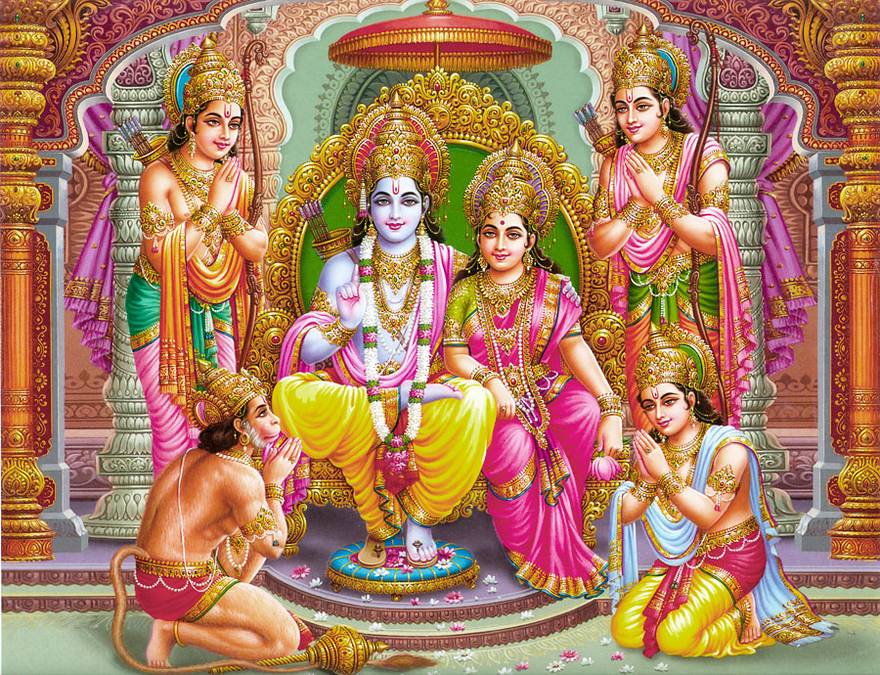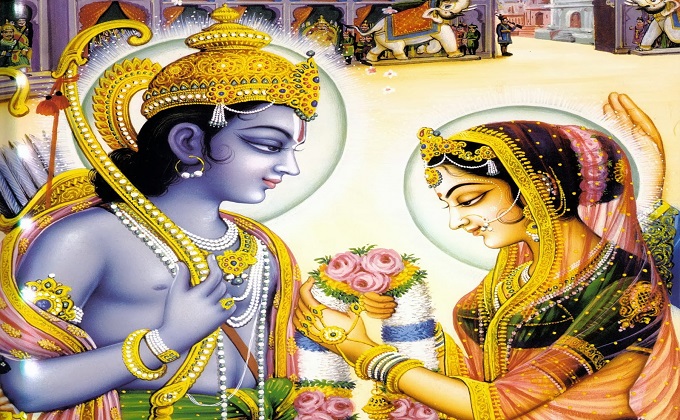
Sri Rama Navami is the festival that celebrates the birthday of god Sri Rama. Lord Rama, the seventh incarnation of Lord Vishnu, incarnated in human form in the land of Ayodhya. Rama was the Lord Hari Himself, incarnate on earth for the destruction of Ravana. He was well accomplished, beautiful and endowed with royal marks. The word “Rama” literally means one who is divinely blissful and who gives joy to others, and one in whom the sages rejoice. Sri Rama appeared in the month of Chaitra (March – April), on the ninth day of the growing moon (Chaitra Masa, Shukla Paksha, Navami Tithi) and this particular day is celebrated as Sri Rama Navami every year. This year we celebrate the festival on April 5, 2017.
Sri Ramachandra appeared as the son of Dasharatha, the king of Ayodhya, who hailed from the dynasty of Maharaja Ikshvaku (also known as Raghu vamsha). Dasharatha had three wives: Kaushalya, Kaikeyi, and Sumitra, but he had no children. On the advice of Maharishi Vashishtha, the king performed a Putra Kameshti Yajna. As a result the three wives conceived sons. Kaushalya gave birth to Rama and Kaikeyi gave birth to Bharata. Sumitra gave birth to the twins: Lakshmana and Shatrughna.
The life and activities of Sri Rama are explained in detail by the great sage Valmiki in the epic Ramayana. A summarized version of the Ramayana as narrated by Shukadeva Goswami to Parikshit Maharaja is included in the ninth canto of Srimad-Bhagavatam (Bhagavata Purana). Ayodhya is birthplace of Lord Rama and Rama Navami celebrations in Ayodhya are remarkable. Devotees come to Ayodhya from far-flung places. After taking holy dip into river Sarayu Devotees visit Rama temple to participate in birthday celebrations.

Spiritual Significance of Sri Rama Navami
The story of the Ramayan is a classic, eternal, universal message of Dharma versus adharma, of deva versus demon, of good versus evil, as represented in the battle between Rama and Ravana.
Ravana was a brahmin; he was a great scholar who wrote numerous works on scriptural philosophy. He was powerful, dynamic, and beautiful in appearance. As the brilliant, handsome king of Lanka, he had everything one would need to be happy and peaceful. Yet, he was arrogant, egoistic, greedy and lustful. His insatiable desires led him to crave more and more power, more and more money, and more and more ladies to fulfill his every whim.
There is one main difference: Bhagwan Rama’s heart overflowed with divinity, love, generosity, humility, and a sense of duty. Ravana’s heart, in contrast, was filled with avarice, hatred, and egoism. Under Bhagwan Rama’s divine touch, the animals became his devotees and his divine helpers. Under Ravana’s touch, even humans became animals.
Through his noble and divine choices, he teaches the world to choose dharma over Artha (when he leaves for the forest rather than be coronated as King) and to choose Moksha over Kama (when he chooses his kingdom over his marriage).
Lord Rama teaches that :
As a son: Respectfully and lovingly obey your father’s orders. Sacrifice your own comfort for your father’s dignity.
As a step-son: Even when your step mother (or mother-in-law) is not kind to you, even when she clearly dis- criminates against you in favor of her own birth child, do not resent her, do not fight against her. Respect her and her wishes.
As a brother: Remain loyal to your brother. Care for him.
As a husband: Protect your wife. Fight for her protection and her purity. But there are times when one’s divine path must even take precedence over the path of householder. Do not keep the role of householder as the ultimate role.
As a King: Sacrifice everything for your people. Do not worry about your own comfort, your own convenience or your own pleasure. Be willing to put the kingdom ahead of your own needs.
Ravana’s ego led to his own demise, first the demise of his spirit and heart and then the demise of his body. He thought he was the one who ran everything. He thought that he was the “doer” of it all. On the other hand, Bhagwan Rama was always humble, and he never took credit for anything. At the end of the war in Lanka, Bhagwan Rama was giving Sitaji a tour of the city, showing her where all of the various events had occurred. When, they reached the place where he victoriously slew Ravana, he reported it to Sitaji only as, “and this is where Ravana died.” He didn’t say, “This is where I crushed the demon,” or “This is where I killed Ravana.”
Ram Navami is a festival that celebrates the birth of Lord Rama, the son of King Dasharath. It was a joyous occasion in Ayodhya all those centuries ago when King Dasharath's heir was finally born. It was like a dream come true for the king as the lack of an heir had troubled him sorely for many years.
Lord Rama is an Avatar of Lord Vishnu who came down to earth to battle the invincible Ravana in human form. Lord Brahma had been receiving complaints from all the gods about the havoc that Ravana was wreaking on earth, but because Lord Brahma had granted Ravana so many boons, he could not be killed by a god. But Ravana had become so overconfident that he would never expect an attack from a human being. So Lord Vishnu agreed to go to earth in the guise of Prince Ram, the son of King Dasharath and Queen Kaushalya.
The story of Lord Rama as told in the great epic Ramayana is one that most Indians know irrespective of caste, creed and religion. Lord Rama is a legendary figure, the epitome of all that is good and true, the man who vanquished the demon king, Ravana. Lord Rama is not just a hero, but has been given the status of a god by the Hindus. Therefore, it comes as no surprise that his birth is celebrated year after year with great pomp and enjoyment on the ninth day after the new moon in Sukul Paksh (the waxing moon), which falls sometime in the month of April.
Fasting Guidelines
The Rama Navami Vrata is nitya or compulsory for the devotees of Rāma and optional for others. It is one of the highly eulogized vratas in the calendar which can destroy one’s sins and also confer even mukti or liberation.
The vrata commences from the previous night itself with fasting. On the navamī day also the votary has to continue fasting, perform worship and homa to Rāma in an image installed in a specially prepared shrine, do japa of Rāmamantra and keep vigil in the night. After the completion of the vrata he donates the image to an ācārya[1] along with other gifts made liberally.
There are three different types of fasts that can be held on this day:
Fasting until noon
Eating only once during the day
Fasting until midnight
Fasting for for nine days beginning on the first day of Chaitra
When eating a single meal during the fast, it may consist of fruits and fruit extracts. Alternatively, if eating a full meal, it can include potatoes made in any form without haldi (turmeric), garlic, ginger or onion, fruits and any type of vegatable. Curd, tea, coffee, milk, and water are also permitted.
Celebration
Ram Navami is celebrated in a variety of ways ranging from bhajan programs and pujas to ratha yatras and pandal programs.
Bhajan programs are organized both at homes as well as in Temples. During these programs, bhajans extolling the virtues of Lord Rama, Lakshman, Sita, and Hanuman are sung. If in a temple, these programs are often accompanied by Ramayana Katha, in which details of the Ramayana are presented, or chanting of the whole Ramayana. Many people either perform akhanda ramayana pat or just chant sunderkand.
Performing akhanda Ramayana Pat involves chanting the entire Ramcharitmanas by Tulsidas, which usually takes 24 hours
Chanting Sunderkand takes three hours. Sunderkand discusses some of Hanuman's exploits and his meeting with Sita in Lanka.
Temples will usually have the chanting of the Valmiki Ramayana or larger pandal programs in which the Ramayana is discussed for nine days, beginning on Ugadi and ending on Rama Navami.
In addition, people clean their homes and put pictures of Lord Rama, Lakshman, Sita and Hanuman on a dais in preparation for the Puja. Flowers and incense are kept before the deities. There are two thaalis kept ready in the puja area. One contains the prasad and the other the items necessary for the puja like roli, aipun, rice, water, flowers, a bell and a conch. The puja begins with the youngest female member of the family applying teeka to all the male members of the family. A red bindi is applied on the foreheads of all the female members. Everyone participates in the puja by first sprinkling the water, roli, and aipun on the gods and then showering handfuls of rice on the deities. Then everybody stands up to perform the aarti, at the end of which ganga jal or plain water is sprinkled over the gathering. The singing of bhajans goes on for the entire puja. Finally, the prasad is distributed among all the people who have gathered.
In Ayodhya, the birthplace of Lord Rama, a huge fair is held with thousands of devotees gathering to celebrate this festival. The fair continues for two days, and rathyatras, carrying the Dieties of Ram, his brother Laxman, His wife Sita, and His greatest devotee Mahavir Hanuman, are taken out from almost all Ram Temples. Hanuman is known for is his devotion to Rama, and his tales form an important part of the celebration.

Popular Bhajans
Some of the popular bhajans sung on this day include the Hare Krishna mahamantra
Hare Krishna Hare Krishna Krishna Krishna Hare Hare
Hare Rama Hare Rama Rama Rama Hare Hare
The Rama Stotra in the Vishnu Sahasranama, say this sloka 3 times as mentioned in the sahasranama.
Sri Rama Rama Rameti Rame Raame Manorame
Sahasra Nama Tat Tulyam Rama Nama Varanane
Sri Rama Nama Varanane Iti
Pilgrimage
People visit sacred places associated with Lord Ram during this holy time. Places like Ayodhya, Ujjain and Rameshwaram attracts thousands of devotees across the country. In Rameshwaram, thousands take a ritual bath in the sea before worshipping at the Ramanathaswamy temple. Many places in North India host fairs in connection with the festival, culminating in spectacular fireworks on Rama Navami.
It is said that the repetition of his name (Rama Nama) is the surest, fastest and easiest way to attain purity, peace, wisdom, understanding, joy, prosperity and ultimately liberation. Bhagwan Rama Himself said, “Repetition of My name once is equal to the repetition of one thousand names of God or to the repetition of a Mantra one thousand times.”
Please download Sri Ramanavami special devotional songs on your android device 